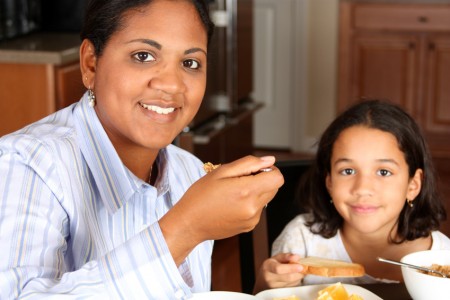 Childhood obesity remains a prominent health concern within our society. According to the 2000 Center for Disease Control and Prevention growth chart, in 2010, more than one third of children were defined as obese, meaning their body mass index (BMI) was at or above the 95th percentile for age and sex.
Childhood obesity remains a prominent health concern within our society. According to the 2000 Center for Disease Control and Prevention growth chart, in 2010, more than one third of children were defined as obese, meaning their body mass index (BMI) was at or above the 95th percentile for age and sex.
CHOC Children’s Community Education department, in partnership with the hospital’s Clinical Nutrition department, provides various classes to parents and children about healthy living. In recognition of National Childhood Obesity Awareness Month, we sat down with two of our educators, Michelle Lubahn and Amy Frias, to discuss this issue. Michelle and Amy advocate that parents are the primary catalysts for change, and that the road to recovery begins at home.
How is childhood obesity determined?
Michelle: Childhood obesity is determined through calculating a child’s body mass index, or BMI. BMI is a calculation that uses height and weight to estimate an individual’s body fat. While the BMI of an adult is calculated with a straight formula, children’s BMIs are based on gender and age, to allow for the change in body composition that happens as a child gets older. Like a standard growth chart, your child will be ranked in percentiles compared to his peers. If your child’s BMI is in the 85th percentile — meaning it’s higher than that of 85 percent of children his age and gender — he would be considered overweight. If he’s in the 95th percentile, he’s considered obese.
What factors contribute to becoming overweight?
Amy: There are several factors that contribute to becoming overweight, but I would say that the biggest factors are lack of physical activity, large portion size, an increase of fast food intake, an increase in sugary drink intake, and an increase in total screen time. Screen time includes all electronics- time spent on cell phones, on the computer, watching TV, and playing video games. Children should have no more than two hours of total screen time a day, which should be in conjunction with a minimum of one hour of physical activity.
What are some of the health effects of childhood obesity?
Michelle: Some of the short-term effects of childhood obesity include a decline in self-esteem, a decline in socialization, and an increased likelihood of depression. It creates a vicious emotional cycle. As the depressed feelings increase, a child is more likely to become an emotional eater, which perpetuates the cycle.
Amy: There are several long-term effects of childhood obesity. Adults who were obese as children may experience health problems much earlier in life in comparison to those adults who maintained a healthy weight through childhood. Some of these health problems include an increase in sugar levels, an increase in lipid levels, and an increase in triglycerides.
What recommendations to do you have for parents trying to implement healthy habits in the home?
Michelle: There are a lot of things that parents can do! The most important thing for parents is to model good eating habits, because they are the first and the best role models for their children. Eat as a family at the dinner table, with the TV off, as often as possible. Keep lots of healthful options available and limit the number of unhealthy options. Also, don’t enforce the “Clean Plater’s Club” at home, meaning don’t emphasize the importance of finishing the entire meal. The best thing to do is work with your child’s needs. I tell my children that they can’t have dessert unless they finish all their vegetables.
Amy: It also helps to plan meals ahead of time and encourage healthy eating throughout the day. For example, bring fruit in the car when you pick your kids up from school, so they eat that rather than choosing a less healthy option once they arrive home. Another tip that works for me is to prepare vegetables before preparing the rest of dinner, so kids can snack on those while they wait for the rest of the meal to be ready. I encourage my children to play outside while I make dinner, which gives them another opportunity to be active.
How can parents encourage a healthy body image?
Amy: Teach kids to feel good about the person they are, not what they look like. Focus on their overall health and promoting good habits rather than focusing on numbers, like weight.
Do you have any other advice for parents?
Amy: I think that the best way to create movement toward a healthier lifestyle is to promote the change as a family unit, rather than trying to encourage your child to change his individual habits. Go for a family hike, or play a game together outside.
Michelle: I think the most important thing is to keep a positive attitude. Learn from your mistakes as a parent and work with your child to make healthy choices. Know that it’s never too late to start living a healthy lifestyle!
Learn more about classes offered by CHOC Children’s Community Education department.





